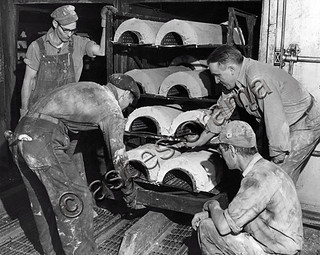Asbestos Manufacturers
Major suppliers of asbestos-containing products include Johns Manville, National Gypsum Company and Armstrong World Industries. Many companies involved in manufacturing and chemical-refining also relied heavily on asbestos at their facilities.

Written byDaniel King•Edited ByWalter Pacheco•Scientifically Reviewed ByDiana Zuckerman, Ph.D.
Asbestos.com is the nation’smost trustedmesothelioma resource
The Mesothelioma Center at Asbestos.com has provided patients and their loved ones the most updated and reliable information on mesothelioma and asbestos exposure since 2006.
Our team of Patient Advocates includes a medical doctor, a registered nurse, health services administrators, veterans, VA-accredited Claims Agents, an oncology patient navigator and hospice care expert. Their combined expertise means we help any mesothelioma patient or loved one through every step of their cancer journey.
30多个贡献者,包括间皮瘤doctors, survivors, health care professionals and other experts, have peer-reviewed our website and written unique research-driven articles to ensure you get the highest-quality medical and health information.
About The Mesothelioma Center at Asbestos.com
- Assisting mesothelioma patients and their loved ones since 2006.
- 帮助超过50%的间皮瘤患者成岩作用osed annually in the U.S.
- A+ rating from the Better Business Bureau.
- 5-star reviewed mesothelioma and support organization.
Testimonials
My family has only the highest compliment for the assistance and support that we received from The Mesothelioma Center. This is a staff of compassionate and knowledgeable individuals who respect what your family is experiencing and who go the extra mile to make an unfortunate diagnosis less stressful. Information and assistance were provided by The Mesothelioma Center at no cost to our family.LashawnMesothelioma patient’s daughter
How to Cite Asbestos.com’s Article
APA
King, D. (2023, September 26).Asbestos Manufacturers.Asbestos.com. Retrieved October 11, 2023, from //www.magnakarsa.com/companies/
MLA
King, Daniel. "Asbestos Manufacturers."Asbestos.com, 26 Sep 2023, //www.magnakarsa.com/companies/.
Chicago
King, Daniel. "Asbestos Manufacturers." Asbestos.com. Last modified September 26, 2023. //www.magnakarsa.com/companies/.
Rise of the Asbestos Industry
Beginning in the late 1800s, American companies, such as Johns-Manville, amassed great wealth by mining, manufacturing and selling asbestos-containing products.
A century later, evidence revealed Johns-Manville and numerous other companies not only knew about the potentially deadly effects ofasbestos exposurebut also went to great lengths to conceal the information from workers and consumers.
The asbestos industry prioritized corporate profits over public health and the value of life.
During the middle decades of the 20th century,asbestos materialswere prevalent in U.S. industries including shipbuilding, construction, power generation and heavy manufacturing.
But a wave of personal injury claims in the 1970s drove hundreds of asbestos suppliers and companies to bankruptcy. Overwhelmed by claims against them, they set up asbestos trust funds to cover the costs of current and future lawsuits.
疾病的担忧aused by asbestos exposure prompted more than 50 nations — including the entire European Union — to ban or severely restrict asbestos use. Strict U.S. regulations took hold in the 1970s.
Companies That Manufactured Asbestos Products
- A.B.B. Lummus Global Inc.
- AC & S
- A.P. Green Industries
- Abex Corporation
- Amatex Corporation
- Armstrong World Industries
- Babcock & Wilcox
- Bell Asbestos Mines
- Bestwall Gypsum
- Borg Warner Company
- Burnham Holdings
- C.E. Thurston & Sons
- Celotex
- CertainTeed Corporation
- Cleaver-Brooks
- Combustion Engineering
- Congoleum Corporation
- Crown Cork and Seal
- Daimler Chrysler
- Dana Corporation
- EaglePicher Industries Inc.
- Ehret Magnesia
- E.J. Bartells Company
- Federal-Mogul Corporation
- Flexitallic Gasket Company
- Ford Motor Company
- Foseco
- Foster Wheeler
- GAF Corporation
- Garlock
- General Electric
- General Motors
- Gold Bond
- H.K. Porter Inc.
- Harbison-Walker Refractories Co.
- Honeywell Heating
- Ingersoll Rand
- Imerys
- J.T. Thorpe Inc.
- John Crane
- Johns Manville
- Johnson & Johnson
- Kaiser Aluminum
- Kelly-Moore Paint Co.
- Kentile Floors
- Leslie Controls, Inc.
- Lincoln Electric
- M.H. Detrick Company
- Malleable Iron Range Company
- Mergenthaler
- Minnesota Mining & Manufacturing
- Mobil Oil Corporation
- National Gypsum
- Nicolet/Keasbey & Mattison
- North American Refractories
- Owens Corning Fiberglass
- Owens Illinois
- Pacor Incorporated
- Pittsburgh Corning
- Plibrico Company
- Porter Hayden Company
- Rapid-American/Philip Carey Manufacturing
- Raybestos Manhattan Raymark Industries
- Republic Powdered Metals
- Rock Wool Manufacturing Co.
- Rutland
- Shook & Fletcher
- Synkoloid Company
- The Flintkote Company
- Unarco
- Union Carbide
- W.R. Grace
- Western MacArthur
- Westinghouse Electric

History of Asbestos Manufacturing
Although asbestos mining existed for thousands of years, it was only during the Industrial Revolution of the 1800s that the industry flourished. Asbestos’ natural resistance to heat, chemicals and electricity made the fibrous mineral desirable for innumerable industrial applications.
Manufacturers first incorporated asbestos insulation into steam engines, piping and locomotives. Thousands of other uses later emerged, and asbestos manufacturers began putting it in products such as boilers, gaskets, cement, roofing materials and automotive brake pads.
Asbestos Companies Valued Profit over Safety
20世纪初,一些石棉公司realized their primary source of income was severely injuring employees and consumers. But rather than improving workplace safety standards, executives ignored information that would damage their business and reputation.
Internal documents indicate Johns-Manville executives were aware of the risks as early as 1934. The company conducted private medical studies on asbestos exposure around this time, and they kept the incriminatory results confidential. It was an asbestos cover-up that lasted decades.
In addition to Johns Manville, other leading asbestos manufacturers include:
- Owens Corning/Fibreboard Corp.
- Raybestos-Manhattan Co.
- National Gypsum Corporation
- W.R. Grace & Co.
- Celotex Corp.
Asbestos use increased throughout World War II, largely because of military shipbuilding contracts. The U.S. government required U.S. Navy and Coast Guard vessels use asbestos insulation.
Decades after the war, hundreds of asbestos companies grew and prospered by incorporating asbestos in thousands ofindustrial and household products.
Products

During the peak era of asbestos consumption, the toxic mineral was incorporated into approximately 3,000 types of products. One of the most common commercial applications was insulation products for construction, shipbuilding and industrial manufacturing.
Countless other types of building materials were manufactured with asbestos, including ceiling tiles, joint compounds, cement, drywall and roofing materials. To this day, these building products have a high potential to release toxic fibers into the air during renovation and demolition work.
Asbestos has also been spun into various textile products such as rope, cloth and garments.Shipyardworkers who installed asbestos insulation often wore protective gloves and aprons that also contained the dangerous ingredient.
Another leading sector that continues to use asbestos materials is the automotive industry. Many car parts that withstand high temperatures and friction, such as gaskets and brake pads, may still contain some asbestos.
Industries & Occupations

According to the World Health Organization, about 125 million people have experienced workplace asbestos exposure worldwide. By far, the mostdangerous occupationsinvolve mining and processing the mineral. These activities release massive amounts of toxic fibers into the air.
Another industry with high exposure risks is construction. American drywall hangers and insulation workers faced constant asbestos exposure risks, and many other professions related to carpentry may have been exposed while working at the same site.
Shipyard workers, especially during the World War II era, experienced heavy exposure as well. Asbestos insulation was once a staple aboard seafaring vessels, and the cramped working conditions made its installation especially hazardous. Also at risk were pipefitters, boiler workers and electricians who serviced Navy ships.
Downfall of US Asbestos Industry
By the 1960s, scientists had gathered ample evidence of asbestos’s harmful effects. A landmark occupational study conducted by Dr. Irving Selikoff in 1964 showed a clear link between the mineral and various types of cancer.
The research indicated that between 1943 and 1962, an excessive number of insulation workers died of asbestosis and malignant diseases such as lung cancer,mesothelioma, stomach cancer and colorectal cancer.
More medical evidence came in to bolster Selikoff’s findings, and the result was a significant downturn for America’s asbestos industry.
The U.S. Environmental Protection Agency dealt another blow to the industry with the Clean Air Act of 1970. It established the National Emission Standards for Hazardous Air Pollutants (NESHAP), which placed stringent restrictions on the use of asbestos and other harmful airborne contaminants.
Several new regulations directly affected the industry, specifically companies that milled, sprayed or disposed of asbestos materials. By the late 1970s, many companies began phasing the mineral out of their products.
Asbestos Manufacturing Today
Even with bills and other legislative efforts to ban the mining and production of asbestos resounding across the world, the industry continues to thrive. Russia, China and Kazakhstan still mine and sell massive quantities of the toxic mineral on a global scale.
According to a 2011 inventory of more than 60,000 asbestos-laden products, approximately 600 companies and suppliers operated worldwide that year.
Although the U.S. Geological Survey asserts that U.S. asbestos use has fallen 99.9% since 1973, the toxic mineral is not yet banned in the United States. Limited amounts of chrysotile asbestos remain in various textiles, building materials such as cement, and brake pads and other friction materials.
The U.S. chloralkali industry continues to import asbestos for use in chlorine production, with annual asbestos imports at 750 tons in 2018.
The U.S. Environmental Protection Agency completed a risk assessment of current asbestos uses in the U.S. in 2019. The agency is currently working to propose and finalize actions to address risks.
Asbestos Litigation
A staggering number of asbestos lawsuits surfaced over the past half-century, jeopardizing the assets of any company associated with asbestos. According to one report, by 2002 an estimated 730,000 people had filed asbestos-related claims against at least 8,400 corporations.
According to a2021 KCIC litigation review, there were 3,685 asbestos lawsuit filings in 2020, a 11% decrease from 2019. The majority of filings were related to mesothelioma (1,827 lawsuits), followed by asbestos-related lung cancer (1,484 lawsuits).
Some asbestos litigation has resulted in multimillion-dollar verdicts or out-of-court settlements. When courts find asbestos companies liable for a person’s injury or death, the companies must provide compensation for medical expenses, lost income, loss of consortium and pain and suffering. Aqualified mesothelioma lawyercan help patients file a claim for compensation including asbestos trust funds.
Many times courts also demand additional punitive damages from companies to discourage future wrongdoing.
Common Questions About Asbestos Companies
- Who made asbestos products?
-
虽然石棉的使用可以追溯到古代mes, companies such as Johns Manville started using it to manufacture fire-resistant roofing in 1858. Other American companies also began mining, manufacturing and selling asbestos-containing products in the late 1800s.
- Is asbestos still manufactured?
-
Manufacturers are still developingproducts containing asbestos, such as gaskets and brake pads. Products containing less than 1% of asbestos are not required to display a warning label to consumers.
- What countries have not banned asbestos?
-
Countries around the world without anasbestos baninclude:
- United States
- Russia
- China
- India
- Singapore
- Mongolia
- Ukraine
- Can asbestos companies be held accountable for asbestos exposure?
-
Asbestos companies are being held responsible for negligence and harm caused by exposing their workers and consumers to toxic substances that causemesotheliomacancer.Mesothelioma compensationis available to anyone with a confirmed diagnosis and a history of asbestos exposure.
- What companies remove asbestos?
-
Companies that specialize in asbestos removal are called asbestos abatement companies. These professionals are licensed and trained in safety standards for properly handling asbestos without risking exposure to themselves or the building’s occupants.
Those looking to hire anasbestos abatements companyshould contant a local team of professionals and ask about their qualifications and specialties, such as environmental services, demolition services and general contracting services.









